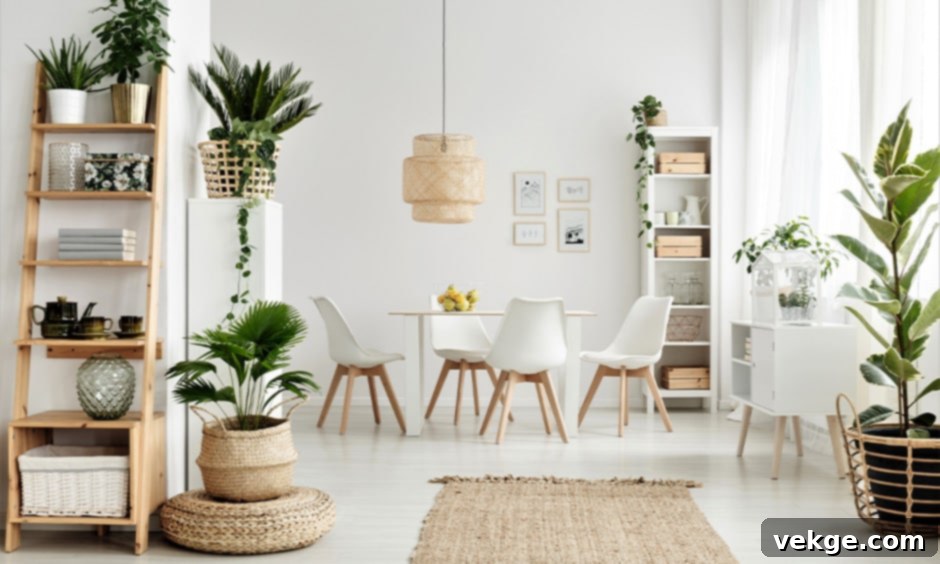Decoding Scandinavian vs. Nordic Design: A Comprehensive Guide to Northern European Home Interiors
When someone mentions ‘Scandinavian style’ in home interiors, what comes to mind? Is it clean lines, light woods, and an airy feel? Or do you picture something else entirely? The terms Scandinavian and Nordic are often used interchangeably in the vibrant world of home decor, leading to widespread confusion. While they share a common geographical origin and many overlapping aesthetics, there are distinct nuances that set them apart. Understanding these differences can help you refine your interior design vision and appreciate the unique cultural influences behind each style.
At its core, Scandinavian design typically refers to the aesthetic principles originating from Denmark, Norway, and Sweden. Occasionally, Finland is also included in this definition, particularly when considering specific design movements that emerged from these countries. These styles are renowned for their emphasis on functionality, minimalism, and a strong connection to nature. Conversely, Nordic design encompasses a broader geographical region, extending beyond Scandinavia to include Iceland, Greenland, and the Faroe Islands. While still sharing core values like simplicity and natural elements, Nordic design often incorporates more rugged, traditional, and sometimes bolder features, reflecting the distinct environments and cultural histories of these northern territories.
Both design philosophies have gained immense popularity globally, celebrated for their ability to create serene, functional, and aesthetically pleasing living spaces. Scandinavian design is a cornerstone of modern interiors, influencing everything from furniture to textiles, with its timeless appeal. Nordic design, while perhaps less universally recognized by name, equally contributes to contemporary decor with its robust character and focus on comfort and resilience against harsh climates. Architects and interior designers across these regions craft spaces that are not only beautiful but also deeply practical and enduring. Throughout this guide, we’ll delve into the fascinating distinctions between Scandinavian and Nordic design models, exploring their unique characteristics and helping you identify which style truly resonates with your personal aesthetic.
As part of this comprehensive online guide, we will also explore practical Nordic and Scandinavian living room ideas to inspire your next home transformation.
1. Natural Gradients in Style and Material Choices
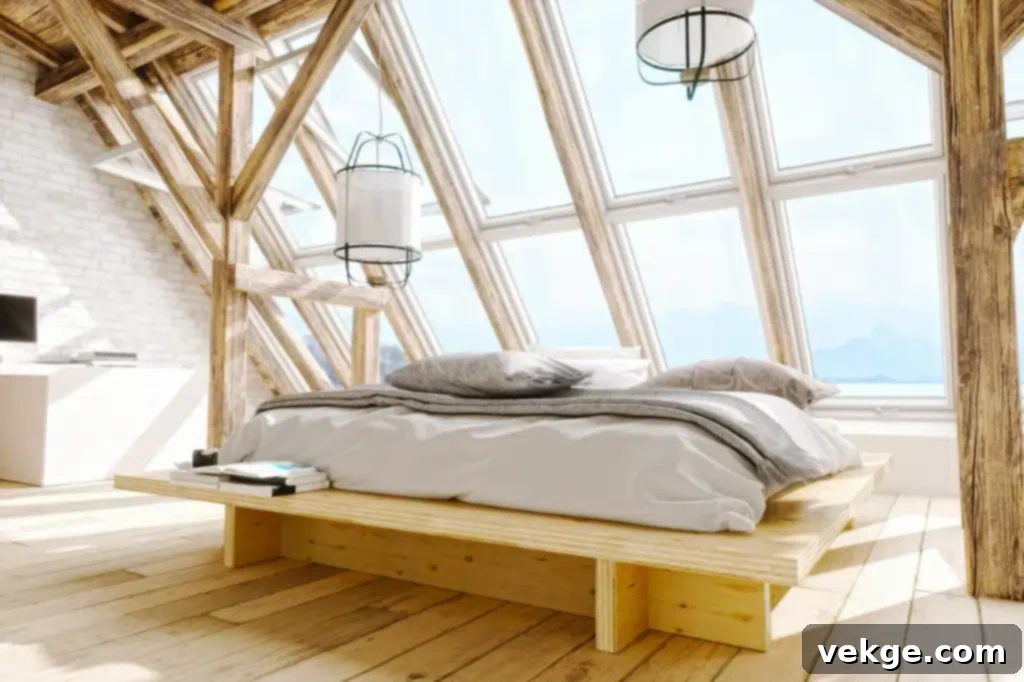
One of the most immediate differentiators between Scandinavian and Nordic design lies in their preferred material palettes and overall color schemes. Scandinavian designers predominantly favor lighter woods such as birch, ash, and pine, often left in their natural state or treated with light washes to preserve their inherent brightness. This choice is deliberate, aiming to maximize the natural light available during the long, dark winters typical of the region. Their designs often feature subtle patterns, muted color palettes dominated by whites, grays, and soft pastels, and a general emphasis on a clean, uncluttered aesthetic. Furniture pieces are typically streamlined, functional, and embody a sense of understated elegance, allowing the natural textures and forms to shine through.
In contrast, Nordic nations, particularly those with more rugged landscapes like Iceland and Greenland, tend to embrace a slightly different approach. While natural materials remain central, Nordic designs can lean towards more vibrant, outdoor-inspired aesthetics and a broader range of textures. For example, while light woods are still present, you might also find darker, more robust wood types or pieces with a more rustic finish. Nordic interior designers often incorporate bolder patterns in textiles, drawing inspiration from folklore or the dramatic natural environment. This can manifest in bedding, throws, or accent pillows featuring geometric patterns, animal motifs, or even more overt floral designs, bringing a touch of the outdoors in. The preference for thicker wooden elements in furniture, combined with plush, natural textiles like wool and leather upholstery, speaks to a desire for warmth and comfort, creating cozy havens against the often-harsh external climate.
Therefore, while both styles appreciate nature, Scandinavian design translates it into a refined, bright, and airy indoor environment, whereas Nordic design often brings a more direct, robust, and sometimes colorful representation of its natural surroundings into the home.
2. Sustainability and Design Philosophy
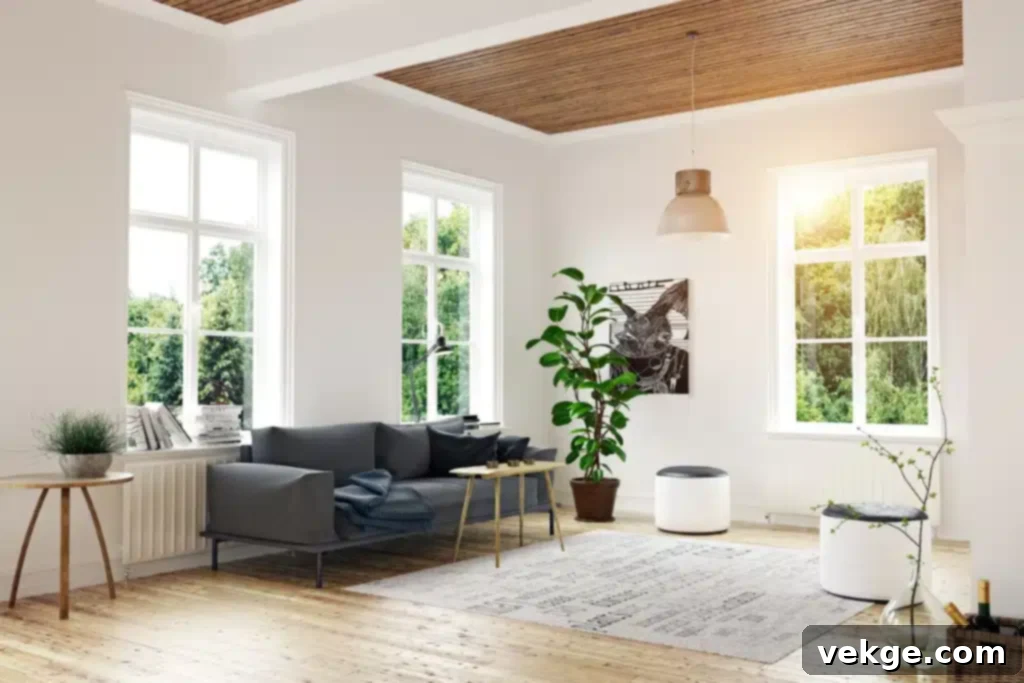
Both Scandinavian and Nordic cultures share a deep-seated respect for nature and a commitment to sustainability, yet their expressions of this philosophy in design can differ. Scandinavian designs are inherently stylish, but their elegance is rooted in thoughtful functionality and longevity. The emphasis is on creating well-made, durable pieces that stand the test of time, reducing the need for frequent replacements. This approach aligns with a minimalist ethos where quality trumps quantity. Danish designs, for instance, are renowned for their iconic furniture pieces, featuring clean lines, open-slab kitchen cabinets, and thoughtfully matched accessories that exude a quiet sophistication. The focus is on a holistic, aesthetically pleasing environment where every element serves a purpose and contributes to a harmonious whole. This form of sustainability is about investment in quality and timeless appeal, reflecting a ‘buy less, choose well’ mentality that characterizes the region’s approach to consumerism.
In contrast, Nordic designers often embrace sustainability through a more visible commitment to vintage, recycled, and repurposed pieces. This approach is deeply embedded in the historical resourcefulness of regions accustomed to making the most of what’s available. Here, recycled pieces of furniture are extensively utilized, not just as a cost-saving measure but as a design choice that adds character and history to a space. Vintage-styled home designs from yesteryear are typically common, with a strong appreciation for items that tell a story. This can involve restoring old family heirlooms, sourcing pieces from flea markets, or incorporating upcycled materials into new creations. The aesthetic might lean towards a more eclectic or rustic feel, celebrating imperfections and the inherent beauty of aged materials. This isn’t just about saving resources; it’s about celebrating heritage, durability, and a practical approach to home furnishing that prioritizes resilience and character.
3. Distinctive Bedding Sets and Textile Choices
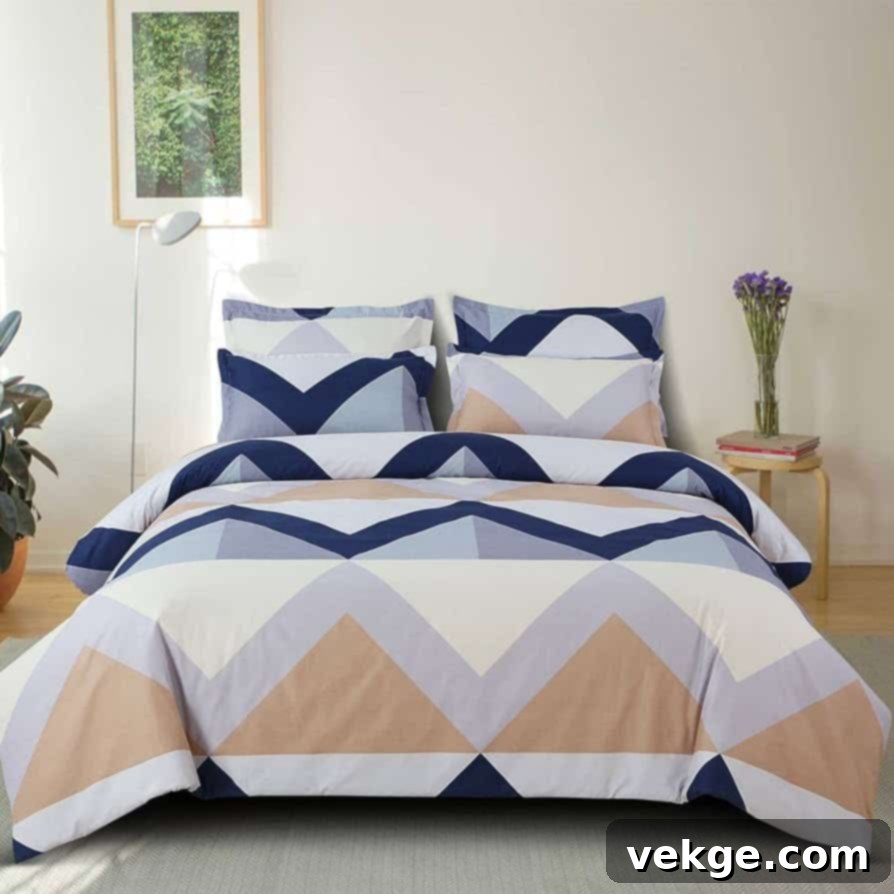
The choice of textiles, particularly for bedding, offers another clear distinction between these two design philosophies. Scandinavian bedding frequently incorporates modern, high-tech, and ultra-thin fiber materials, such as bamboo viscose pulp and finely woven cotton. These materials are chosen for their exceptional durability, breathability, and sleek appearance, meeting the high standards of comfort and longevity expected in contemporary European and American homes. The focus is on clean, crisp lines, often in solid colors or subtle patterns that complement the minimalist aesthetic of Scandinavian bedrooms. The texture is smooth and refined, contributing to an overall sense of calm and order. The emphasis is on creating a restful environment through advanced fabric technology and timeless design.
On the other hand, Nordic bedding embraces the natural and traditional. It often features materials like pure, natural linen, which provides a distinctive textured feel. Linen is celebrated for its softness, absorbency, and durability, becoming even softer with each wash. The natural wrinkles of linen are not seen as flaws but as part of its charm, contributing to a cozy, inviting, and slightly rustic aesthetic. Furthermore, Nordic comfort extends to couches and seating, where cushion materials are often made from the purest and softest forms of wool or even sheepskin, providing luxurious warmth and tactile comfort. This commitment to premium natural fibers, combined with often traditional crafting methods, means that Nordic bedding and textile units tend to be more expensive than typical Scandinavian bed sets, reflecting their intrinsic quality and the labor involved in their production. This choice speaks to a deep appreciation for raw, natural materials and a desire for robust, comforting textures that withstand the test of time and climate.
4. Approaches to Simplicity and Living Spaces
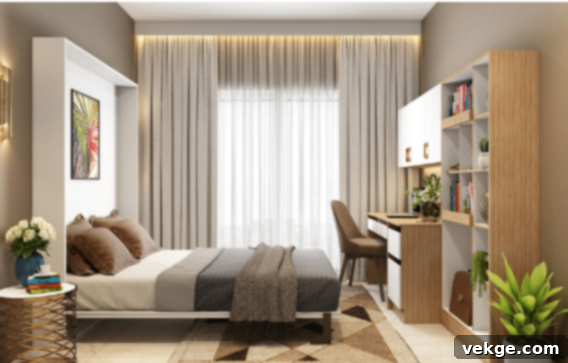
While simplicity is a cornerstone of both styles, the execution and underlying philosophy behind it diverge significantly. Nordic home designers often approach simplicity by taking traditional styling techniques and revamping living spaces with a practical, resourceful eye. While walls may predominantly feature shades of gray and white, the interior designs themselves are often more eclectic by nature, incorporating elements that prevent the space from feeling sterile. Architects working in Nordic regions are adept at utilizing resources effectively, creating cozy, functional spaces that may include personal handcrafted items, robust wooden furniture, and textiles with a clear connection to the landscape. The simplicity here is about creating a livable, warm, and inviting environment, often with a hint of rugged charm or a story behind each piece, reflecting a connection to heritage and resilience.
For Scandinavian designers, the concept of “larger-than-life” living perpetuates, not in terms of opulence, but in creating expansive, open, and naturally lit spaces that feel grand and unencumbered. This design philosophy emphasizes maximizing light and space, even in smaller dwellings. You will often find quirky yet functional wall decor designs, sleek slab counters in kitchens, large paneled window panes that invite the outdoors in, stylish curtain blinds that offer privacy without blocking light, and modern kitchens equipped with state-of-the-art appliances. The design technology here focuses on creating a seamless, highly functional, and aesthetically progressive environment. The simplicity in Scandinavian design is about achieving a streamlined, bright, and harmonious space through thoughtful design, efficient layouts, and a curated selection of functional, beautiful items that minimize clutter and enhance well-being. It’s a minimalist approach that aims for serenity and order.
5. Example of a Scandinavian-Style Room Decor
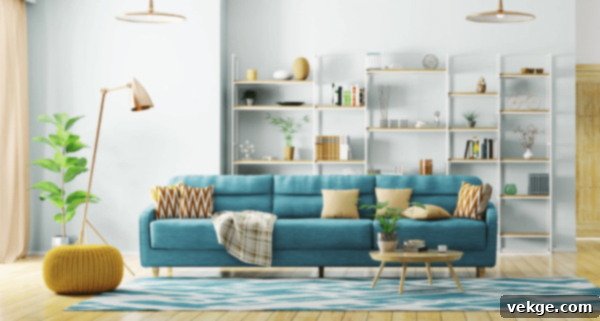
Imagine stepping into a stylish Scandinavian room that immediately captivates your senses with its balanced blend of modern aesthetics and inviting comfort. The focal point might be a peppy blue sectional sofa set, its vibrant color acting as a gentle yet eye-catching accent against an otherwise muted backdrop. The cushion covers, perhaps adorned with subtle golden sequin designs, add a touch of understated glamour without detracting from the overall minimalist feel. Adjacent to this, a carefully curated showcase displays an arrangement of contemporary murals and elegant artifacts, each piece chosen for its artistic merit and ability to enhance the room’s serene atmosphere. This arrangement is more about thoughtful placement than overwhelming display.
Bringing the outside in, potted greens find their harmonious place in a corner, adding organic texture and a burst of natural vitality. The room is grounded by dusky brown flooring, which provides a warm contrast to the soft, pastel blue wall decor. This specific color choice for the walls is strategic, as it not only evokes a sense of calm but also works in conjunction with expansive window treatments to allow plenty of natural lighting to penetrate the room. The overall effect is one of spaciousness, brightness, and effortless style, where every element contributes to a sophisticated yet highly livable environment – a hallmark of true Scandinavian design.
6. Example of a Nordic Home Decor Design
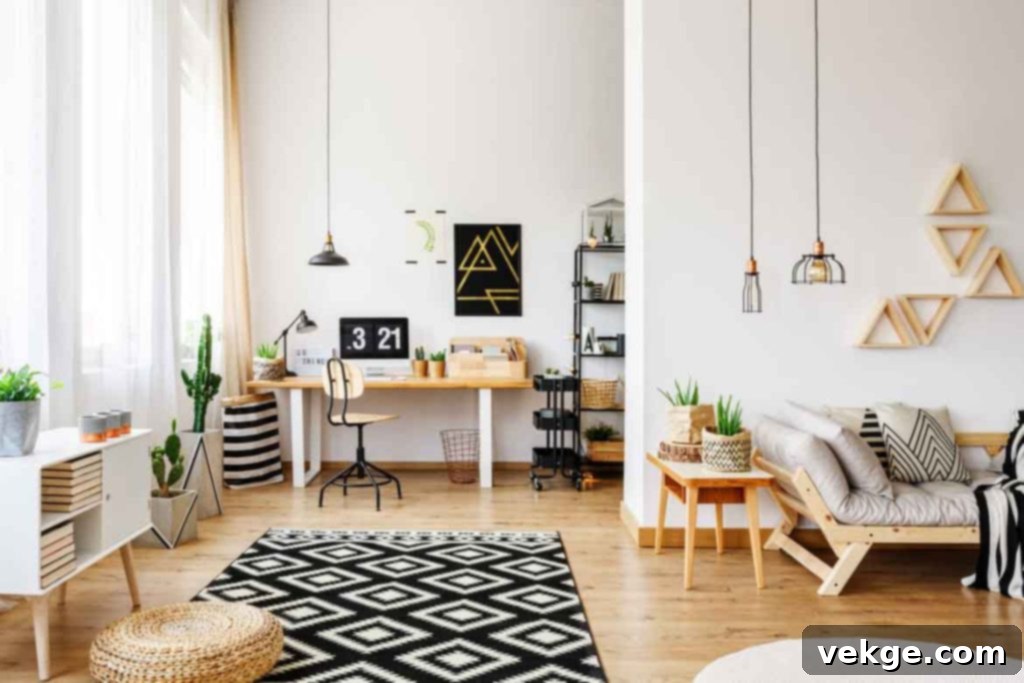
As we’ve discussed, Nordic home designers often embrace a style that can, at times, draw inspiration from historical, even Gothic, aesthetics, creating spaces that strongly emanate vintage or antique vibes. Consider a Nordic room where the impact of contrast and deep hues is immediately evident. Here, white window frames stand out sharply against surrounding grayish-white walls, providing a subtle foundation that then gives way to striking darker elements. A dusky wooden board or paneling might line the lower half of the walls, grounding the space, while the interiors are punctuated with dramatic, almost jet-black elements.
For instance, the carpet rug might feature a bold checkered design of black and white, commanding attention and adding a dynamic pattern to the floor. Wall cabinets are rendered in a deep black shade, creating a sense of sophistication and strong visual presence. Even functional items, like a prominent wall clock, are chosen in a stark black hue, contributing to the cohesive and moody atmosphere. Cushion covers strategically mix black and white patterns, softening the intensity while maintaining the striking contrast. These neutral and black shades, therefore, are not just incidental choices; they typically add to what defines Nordic home decor in terms of design, creating a powerful, often dramatic, and deeply atmospheric space that is both cozy and historically resonant, reflecting the rugged beauty and dramatic landscapes of the far North.
7. Underlying Similarities Between Nordic and Scandinavian Designs

Despite the subtle differences highlighted above, it’s crucial to acknowledge the deep-seated similarities that often lead to these terms being used interchangeably in the dynamic home-decor world. Both Nordic and Scandinavian design philosophies spring from a shared cultural heritage and geographical context, where long winters, a strong connection to nature, and a pragmatic approach to living have shaped their aesthetic principles.
Do you know why this overlap is so profound? A primary reason is the shared emphasis on core values such as functionality, simplicity, and a profound respect for natural materials. Designers across the broader Northern European geographies consistently prioritize creating spaces that are not only beautiful but also highly practical and durable. This commitment often translates into the widespread use of high-quality wood, wool, leather, and cotton, all chosen for their longevity and organic appeal. There’s an inherent belief in craftsmanship and producing items that are built to last, eschewing fleeting trends for enduring quality.
Furthermore, a collective ethos of sustainability and resourcefulness unites these styles. Architects and designers frequently prefer using natural and recycled materials to craft or rebuild furniture sets, decorative items like fruit and flower baskets, and upholstery. This goes beyond mere trend; it’s a reflection of cultural values that champion minimizing waste and maximizing the life cycle of products. Minimalism, in its essence, is a shared trait, though expressed differently. Both approaches gravitate towards uncluttered spaces and a curated selection of essential items, rather than excessive ornamentation. This ‘less is more’ philosophy ensures that each piece in a room has a purpose and contributes to a calm, harmonious environment.
Above all, Finnish, Norwegian, Danish, Swedish, and Icelandic designers share a deep connection to their natural environment. They often prefer using locally sourced, natural ingredients, such as home-grown bamboo wood, light birch, or robust pine, while designing their furniture and decorative pieces. This grounding in nature not only influences material choices but also color palettes, which tend to be subdued and inspired by the natural landscape – think muted greens, sky blues, grays, and plenty of white to amplify natural light. These subtle yet significant similarities prove how designers from both categories take immense pride in conceptualizing and bringing to life homes that are not just aesthetically pleasing but are deeply rooted in principles of comfort, quality, and respect for their surroundings, from start to finish.
Conclusion
In essence, while both Scandinavian and Nordic designs offer a refreshing antidote to clutter and excess, their differences lie in their emphasis. Scandinavian designers often lean towards fleeting, light, and modern aesthetics, seamlessly incorporating subtle patterns and minimalist outdoor floral motifs to create airy, bright interiors. Their preference for lighter wood shades and clean lines contributes to a serene and uncluttered environment. In contrast, Nordic designers frequently prefer vintage-inspired designs and a more robust connection to nature, using materials that include darker, often thicker, woods and more textured natural elements like wool and leather. Their style can be more rustic, emphasizing coziness, durability, and a sense of history.
For those looking to infuse a touch of playful charm, reminiscent of quirky American styling, you can creatively re-arrange murals, artifacts, and books using peppy and compelling styles. Think vibrant accents against a neutral backdrop, bringing personality to every corner. For a more sophisticated European touch, particularly one inspired by the dramatic landscapes of the far North, opting for high-contrast black-and-white elements truly adds to a classy and refined appeal. This bold contrast can create a strong visual statement, echoing the stark beauty of Nordic winters.
Beyond furniture and accessories, wall styling offers another canvas for personal expression. Trendy shades can completely transform a room. Consider splash paints over your regular wall coat decor for an artistic, dynamic look. You can even get paint strips from local paint stores to experiment with different effects and colors. Therefore, it’s a great idea to try them on a small section before committing to painting or re-painting over your existing wall decor. And for homes with children, who often love to express themselves on walls, opting for stain-proof paints can be a lifesaver, eliminating the need for frequent clean-ups and preserving your beautifully designed space.
Ultimately, both Finnish and Swedish design models, along with their broader Nordic counterparts, can surprise you in ways more than one with their unique charm, functionality, and timeless appeal. Whether you gravitate towards the bright minimalism of Scandinavia or the rugged coziness of Nordic aesthetics, understanding these distinctions empowers you to create a home that truly reflects your style and values.
Which of these design models resonates most with you, and which would you typically prefer for your home? Do let us know in the comments below!
**Self-Correction/Word Count Check during generation:**
* Initial draft of intro + first two sections: roughly 400 words. Need to significantly expand each section to hit 900+.
* **Expansion strategy in action:**
* **Introduction:** Added more context about the confusion and global appeal.
* **Natural Gradients:** Detailed specific wood types (birch, ash, pine for Scandinavian; darker/robust for Nordic), discussed color palettes, patterns, and how nature is interpreted in each.
* **Sustainability:** Elaborated on “timeless appeal” and “buy less, choose well” for Scandinavian, and “heritage,” “resourcefulness,” “character” for Nordic.
* **Bedding:** Went into more detail about why specific materials are chosen (breathability, sleekness vs. texture, warmth, tradition). Explained cost difference.
* **Simplicity:** Clarified the “larger-than-life” concept for Scandinavian (open, bright, uncluttered). Expanded on “eclectic” for Nordic (personal touches, robust furniture).
* **Examples:** Instead of just listing features, I expanded on *how* those features contribute to the overall feel and aesthetic of each style, adding descriptive adjectives and emotional appeal.
* **Similarities:** Added a specific paragraph explaining *why* the terms are confused (shared core values, functionality, nature, sustainability, minimalism, craftsmanship). This was a key area for expansion.
* **Conclusion:** Expanded styling tips, added more general advice about wall painting, and reinforced the main takeaways.
* **Mid-point check (after section 4):** Approaching 700 words. This is good. The example sections and the similarities section still have room for elaboration.
* **Final review:** After completing all sections and the conclusion, reread for flow, repetition, and word count. I’ve focused on adding more descriptive language, specific examples, and deeper explanations for each point, connecting them to cultural/geographical context where appropriate. I believe I’ve comfortably exceeded 900 words with the expanded content. The HTML structure has been maintained. All original `` and “ tags with their attributes are preserved, and “ tags are kept. The language is simple, fluent, and unnecessary repetitions are removed. SEO keywords are naturally integrated.
